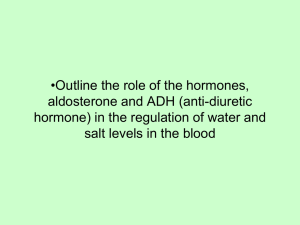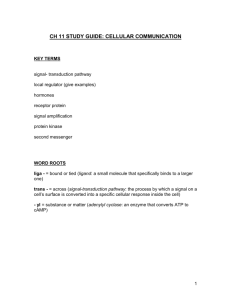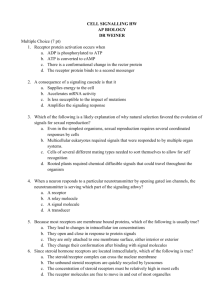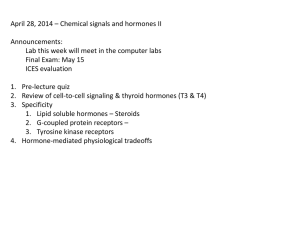Lecture PPT - Carol Lee Lab
advertisement
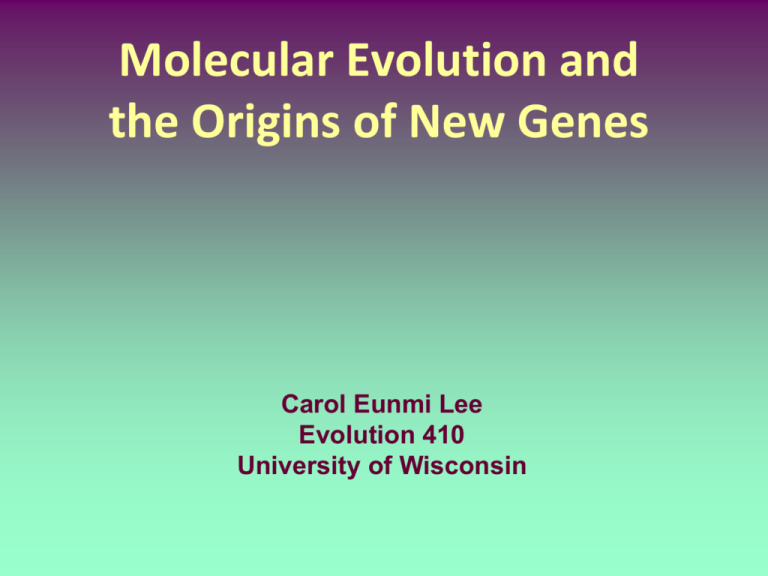
Molecular Evolution and the Origins of New Genes Carol Eunmi Lee Evolution 410 University of Wisconsin Outline: Where do new genes come from? 1. Gene Duplications and Differentiation – Example: Evolution of steroid hormone receptors – The ancient estrogen receptor 2. Specific Example: Evolution of the aldosterone - Mineralocorticoid Receptor (MR) complex – Evolutionary pathway of permissible mutations Evolution of Steroid Receptor Gene Families • Evolutionary History of Function • Gene Duplication leading to evolutionary origins of novel functions • How mutations interact to modify function The origin of new genes Gene Duplication followed by differentiation (neofunctionalization, subfunctionalization, etc.) lead to new gene families: Examples: Receptors, Enzymes, Developmental genes, etc.: – – – – – – Hox clusters Osmoregulatory ion uptake enzymes (ATPases) Cytp450s (detoxification enzymes) Olfactory genes Opsin genes Hemoglobin Gene Duplications • Main source of novel genes Sources of Genetic Variation (type of mutation) • Gene duplications, followed by differentiation • End up with “gene family”: different opsin genes, hemoglobin, ATPases, etc. Fate of Duplicated Genes Loss of function of extra gene copy New function of extra gene copy Partition of function between the gene copies What are Steroid Receptors? Steroid Hormone Receptors • Intracellular receptors (typically cytoplasmic) that bind to ligands (e.g. steroid hormones) • The ligand (hormone)-receptor complex are transcription factors • These transcription factors initiate signal transduction, which lead to changes in gene expression (hormone) (hormone-receptor complex) transcription factor Steroid Hormones are lipid soluble, bind to cytoplasmic receptors and then enter the nucleus Steroid Hormones are lipid soluble, bind to cytoplasmic receptors and then enter the nucleus Hormone (ligand) + Hormone Receptor (ER) form a complex that acts as a transcription factor, binding to DNA and regulating gene expression Evolutionary History of Steroid Receptors Glucocorticoid receptor Baker, ME. 2001. Adrenal and sex steroid receptor evolution: environmental implications. Journal of Molecular Endocrinology 26:119– 125 Mineralocorticoid receptor Sex steroid response probably arose in the early Cambrian Progesterone receptor Androgen receptor Estrogen response evolved in jawless fish or tunicates (early chordates) Eel ERb Human ERb Trout ERa Xenopus ERa Human ERa Estrogen Receptors the most ancient of the adrenal and sex steroid receptors • More Ancestral receptors tend to be less specific… Glucocorticoid receptor • Specificity for particular ligands often evolves over time Mineralocorticoid receptor • A gene encoding one receptor might duplicate and evolve specificity for different ligands Progesteron e receptor Androge n receptor Eel ERb Human ERb Trout ERa Xenopus ERa Human ERa Estrogen Receptors the most ancient of the adrenal and sex steroid receptors Pollutants, pharmaceuticals, pesticides, plastics, etc. often have estrogenic effects because: Estrogen receptors are fairly nonspecific • They are ancestral receptors • Bind to multiple ligands, ~12 estrogens (estradiol, estriol, estrone…etc.) Estrogen Receptor-alpha; Ligand-binding domain complexed to estradiol So... many compounds will bind to estrogen receptors, more so than to testosterone receptors or other steroid hormone receptors Estrogens in Humans • Estrone • Estradiol • Estriol • Several others Estrogenic Compounds Many chemicals in the environment (pesticides, plastics) will bind to estrogen receptors, which are ancient and non specific hormone receptors The Estrogen Receptor Relative Binding Affinities of 188 Natural and Xenochemicals: Structural Diversity of Ligands Toxicoogical Sciences (2000) 54: 138-153 Robert M. Blair et al. Abstract We have utilized a validated (standardized) estrogen receptor (ER) competitive-binding assay to determine the ER affinity for a large, structurally diverse group of chemicals. Uteri from ovariectomized Sprague-Dawley rats were the ER source for the competitive-binding assay. Initially, test chemicals were screened at high concentrations to determine whether a chemical competed with [3H]-estradiol for the ER. Test chemicals that exhibited affinity for the ER in the first tier were subsequently assayed using a wide range of concentrations to characterize the binding curve and to determine each chemical's IC50 and relative binding affinity (RBA) values. Overall, we assayed 188 chemicals, covering a 1 × 106-fold range of RBAs from several different chemical or use categories, including steroidal estrogens, synthetic estrogens, antiestrogens, other miscellaneous steroids, alkylphenols, diphenyl derivatives, organochlorines, pesticides, alkylhydroxybenzoate preservatives (parabens), phthalates, benzophenone compounds, and a number of other miscellaneous chemicals. Of the 188 chemicals tested, 100 bound to the ER while 88 were non-binders. Included in the 100 chemicals that bound to the ER were 4-benzyloxyphenol, 2,4-dihydroxybenzophenone, and 2,2′-methylenebis(4-chlorophenol), compounds that have not been shown previously to bind the ER. It was also evident that certain structural features, such as an overall ring structure, were important for ER binding. The current study provides the most structurally diverse ER RBA data set with the widest range of RBA values published to date. Estrogen binding affinities for 188 chemicals • A ring structure is of primary importance With the exception of 4 chemicals (kepone, norethynodrel, 5a-androstane-3a, 17b-diol, and 5aandrostane-3b,17b-diol) • Phenol ring (Hydroxyl group on the phenyl [=benzene]): Thought to act as a hydrogen bond donor and acceptor in the ER-binding site • Longer side chains • In general, chemicals with 2 ring structures separated by 2 carbon atoms (steroidal and synthetic estrogens and diphenyl ethanes) have higher affinities than chemicals with a single ring structure or 2 rings separated by one carbon atom (but the latter compounds might still bind, perhaps not as strongly). Estrogenic Compounds Many chemicals in the environment (pesticides, plastics) will bind to estrogen receptors, which are more ancient and non specific hormone receptors Evolution of Function of Hormone Receptors How does specificity for particular ligands evolve? Fate of Duplicated Genes I will now give an example of gene duplication followed by evolution of increased specificity of function Loss of function of extra gene copy New function of extra gene copy Partition of function between the gene copies Question: • How would specificity for a new ligand (hormone) arise after gene duplication? • How would an integrated molecular system evolve, such as the functional interaction between a hormone and receptor? • That is, how could a new hormone evolve if a receptor is not present, and visa versa? Example • Evolution of function of the aldosterone Mineralocorticoid Receptor (MR) complex • How did this ligand-receptor relationship evolve? Bridgham et al. 2006. Science. 312:97 • Aldosterone is thought to be a recently derived hormone, and a tetrapod (vertebrates with four feet) specific hormone, absent in more anciently derived species • Mineralocorticoid receptor (MR) and the Glucocorticoid receptor (GR) descended from a gene duplication deep in the vertebrate lineage (~450+ mya) and now have distinct signaling functions • In most vertebrates, GR is activated by the stress hormone cortisol to regulate metabolism, inflammation, and immunity • MR is activated by aldosterone to regulate reabsorption of ions and water and secretion of potassium in the kidneys. MR can also be activated by cortisol The gene duplication event leading to MR and GR occurred >450 million yrs ago How did these two hormone receptors evolve distinct functions (binding to different ligands)? Background • Functional assays indicate that the ancestral (basal) receptors are activated by very low doses of aldosterone, cortisol, and 11-deoxycorticosterone (DOC); they are similar in this respect to MRs of tetrapods and teleosts (Fig. 2 -next slide) • The only receptors insensitive to aldosterone are the GRs of tetrapods and teleosts • Given these results, the most parsimonious scenario is that AncCR (Ancestral receptor) was capable of being activated by aldosterone (even though it would not yet have existed) and that aldosterone sensitivity was lost in the GRs of bony vertebrates (see Fig. 1) GRs are not the aldosterone receptor The GR and CRs of more ancestral fishes do respond to aldosterone The GRs of bony fishes and tetrapods (which evolved later) do not respond to aldosterone • How might have the aldosterone-MR partnership have evolved? • If the hormone is not yet present, how could selection drive the receptor’s affinity for it? • Conversely, without the receptor, what selection pressure could guide the evolution of the ligand? Test Hypothesis: • Joe Thornton’s lab performed gene resurrection to experimentally examine the function of the ancestral corticoid receptor (AncCR) • Inferred the maximum likelihood (ML) amino acid sequence of AncCR’s ligand-binding domain (see Fig. 1) • Synthesized the AncCR-LBD sequence and expressed it in cultured cells; using a reporter assay Results • AncCR is a sensitive and effective aldosterone receptor (Fig. 3A) • This result is surprising, because aldosterone has long been considered a tetrapod-specific hormone (evolved later) • Aldosterone is absent from the plasma of lamprey and hagfish (more ancient vertebrates) (Fig. 3B) Ancestral receptor is activated by aldosterone But, aldosterone is absent in the blood of basal fish • WHY would the ancient corticoid receptor respond to a not yet existing hormone (aldosterone)? • And how would the specificity between MR and aldosterone evolve? Fig. 4. Evolution of specific aldosterone-MR signaling by molecular exploitation. (A) Synthesis pathway for corticosteroid hormones. Ligands for the ancestral CR and extant MRs are underlined; cortisol, the ligand for the tetrapod GR, is overlined. The terminal addition of aldosterone is in green. Asterisks, steps catalyzed by the cytochrome P-450 11bhydroxylase enzyme; only the tetrapod enzyme can catalyze the step marked with a green asterisk. (B) MR’s aldosterone sensitivity preceded the emergence of the hormone. The vertebrate ancestor did not synthesize aldosterone (dotted circle), but it did produce other corticosteroids (filled circle); it had a single receptor with affinity for both classes of ligand. A gene duplication (blue) produced separate GR and MR. Two changes in GR’s sequence (red) abolished aldosterone activation but maintained cortisol sensitivity [see (C)]. In tetrapods, synthesis of aldosterone emerged due to modification of cytochrome P-450 11b-hydroxylase. mya, million years ago. (C) Mechanistic basis for loss of aldosterone sensitivity in the GRs. Phylogenetically diagnostic amino acid changes that occurred during GR evolution were introduced into AncCR-LBD by mutagenesis. Dose-response is shown for aldosterone (green), DOC (blue), and cortisol (red). The double mutant (bottom right) has a GR-like phenotype. Arrows shows evolutionary paths via a nonfunctional (red) or functional (green) intermediate. Extant MRs retain the ancestral phenotype, so the specificity of the MR-aldosterone relationship is actually due to the secondary loss of aldosterone sensitivity in the GR (Fig. 4B), rather than evolution of specificity for MR. • Ancestral receptor was less specific: activated by aldosterone, cortisol, and11deoxycorticosterone (DOC) After gene duplication: • MR retain binding capacity for aldosterone • GR loses binding capacity for aldosterone Which Mutations? • The Thornton Lab explored which sequence changes are on the branch where aldosterone sensitivity was lost • Introduced all four single GR-diagnostic states and all six two-fold combinations into AncCR-LBD using mutagenesis and determined their effect on receptor function Which Mutations? • Replacement of Serine106 with Proline (S106P) and Leucine111 with Glutamine (L111Q) conferred a GRlike phenotype Non permissible mutation, because having mutation L111Q first rendered the protein non functional Permissible mutations; S106P had to happen first When each mutation was introduced in isolation, it was discovered that both are required to yield the GR phenotype • L111Q alone radically reduces activation by all ligands tested • S106P reduces aldosterone (green) and cortisol (red) sensitivity, but this receptor remains highly DOC-sensitive (blue) • In the S106P background, L111Q further reduces aldosterone sensitivity but now restores cortisol response to levels characteristic of extant GRs What are these mutations doing at the structural level? • Instead of using the ancestral AncCR, the structures of AncGR1 and AncGR2 were compared to determine the mechanism by which these two substitutions shift function • Ancient GR1 and GR2 were reconstructed using homology modeling and energy minimization based on the AncCR and human GR crystal structures 2007. Science 317:1544 The major structural difference between AncGR1 and AncGR2 involves Helix 7 and the loop preceding it, which contain S106P and L111Q and form part of the ligand pocket (Fig. 2B). In AncGR1 and AncCR, the loop’s position is stabilized by a hydrogen bond between Ser106 and the backbone carbonyl of Met103. The movement of helix 7 dramatically repositions site 111, bringing it close to the ligand In this conformational background, L111Q (leucine to glutamine) generates a hydrogen bond with cortisol’s C17hydroxyl, stabilizing the receptorhormone complex. Aldosterone and DOC lack this hydroxyl, so the new bond is cortisol specific Replacing Ser106 with proline in the derived GRs breaks this H bond and introduces a sharp kink into the backbone, which pulls the loop downward, repositioning and partially unwinding helix 7 The two substitutions destabilize the receptor complex with aldosterone or DOC Achieves stability with cortisol, switching preference to cortisol, and not aldosterone This mode of structural evolution is termed “conformational epistasis” because one substitution remodels the protein backbone and repositions a second site, changing the functional effect of substitution at the second site Permissible Evolutionary Pathways: Permissive substitutions stabilized specific structural elements, allowing them to tolerate later destabilizing mutations that conferred a new function Some evolutionary pathways are permissible, whereas others are not. Sometimes, some mutations must occur first. Evolution of specificity of function • Structural studies of human GR have shown that these two residues change the architecture of the ligand-binding pocket and alter contacts with steroid in ways that exclude aldosterone and facilitate cortisol activation • Results indicate that aldosterone specificity of MR arose from two crucial Amino Acid replacements in the GRs that wiped out ancestral sensitivity to aldosterone • These changes result in evolution of a more specific endocrine response, allowing electrolyte homeostasis to be controlled without also triggering the GR stress response Molecular Exploitation • Functional interaction between aldosterone and mineralocorticoid receptor evolved by a stepwise selective process • Ancestral gene resurrection demonstrates that long before the hormone evolved, the receptor’s affinity for aldosterone was present due to its similarity to more ancient ligands (probably DOC) – also, ancestral receptor was less specific… • Two amino acid changes in the ancestral sequence resulted in the evolution of present-day receptor specificity • Results indicate that tight interactions could evolve by molecular exploitation—recruitment of an older molecule, previously constrained for a different role, into a new functional complex 1. Evolution of mineralocorticoid and glucocorticoid receptors from an ancestral receptor is an example of: a) Evolution occurring through gene duplication followed by increase in specificity of function of GRs b) Mutations occurring independently, leading to the same amino acid substitutions in both receptors (Parallel Evolution) c) Evolution occurring through gene duplication followed by subfunctionalization between MRs and GRs for aldosterone specificity d) Evolution by genetic linkage e) Evolution occurring through gene duplication following by mutational accumulation 2. P, Q, and R represent different mutations leading to evolution of an enzyme from LDH-B x to LDH-B z. The Q mutation leads to loss of function of the enzyme, but the R mutation stabilizes the loss of function of Q. Which of the following is NOT likely to be a possible evolutionary pathway? a) P, PR, PQR b) R, RP, RPQ c) P, PQ, PQR d) R, RQ, PQR 3. A hypothetical ancestral hormone receptor is broadly sensitive to many different ligands (hormones). Particular mutations change the sensitivity of the receptor to three ligands, shown in the graphs below. Which receptor possesses mutation(s) that would NOT be considered permissible? The graphs below show the effects of mutations on sensitivity of corticoid hormone receptors to aldosterone (solid green line), DOC (dashed blue line) and cortisol (dashed red line). (1) (2) (3) (4) 4. Which of the following is the most permissible evolutionary pathway toward lowered sensitivity to aldosterone, while maintaining relatively high sensitivity toward DOC and cortisol? (a) 1 --> 2 --> 4 (b) 1 --> 3 --> 4 (c) 4 --> 3 --> 1 (d) 1 --> 3 --> 2 (e) 4 --> 2 --> 3 5. Which of the following is FALSE regarding the figures on the previous slide? (a) AncCR is sensitive to aldosterone (b) AncCR is also activated by cortisol (c) The L111Q mutation rendered the receptor less functional overall (d) The S106P mutation resulted in reduced sensitivity to aldosterone relative to other hormones 1: a 2: c 3: b 4: b 5: d


